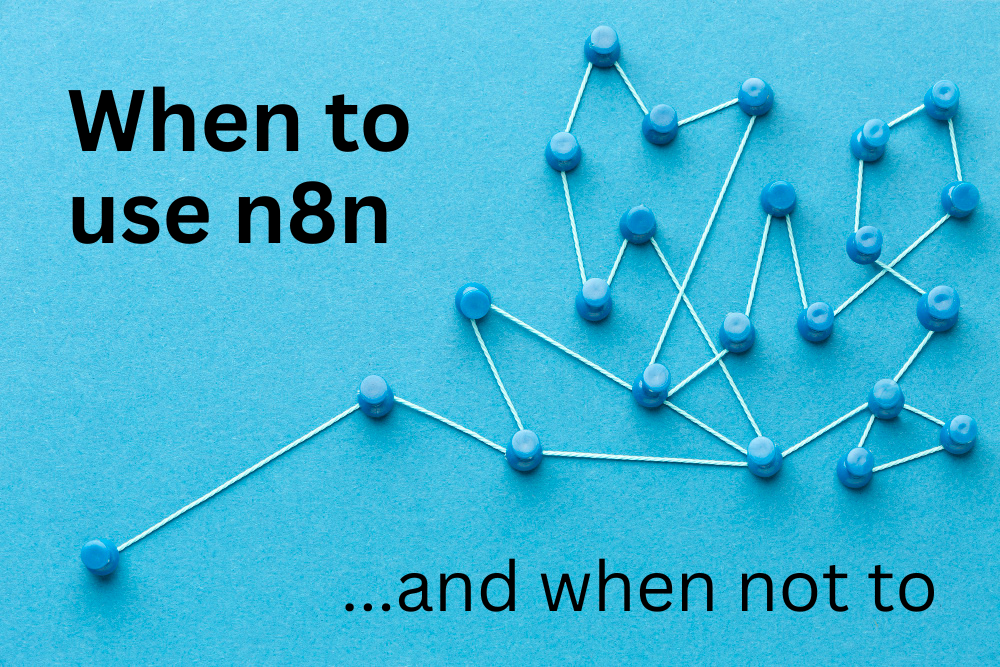Over the last decade, working with AI and automation-heavy systems has taught me something very clearly—building the model is often the easiest part. The real complexity shows up when you’re trying to run these models at scale, with repeatable workflows, human review, retraining logic, logging, and reporting.
I’ve seen teams spend more time wiring APIs and manually triggering scripts than actually improving their models.
That’s where tools like n8n come into play. It’s a low-code, open-source workflow automation platform that allows you to visually design and automate sequences of actions—from HTTP calls to Slack notifications to database updates.
But it’s not a silver bullet.
This blog walks you through real use cases where n8n works great for AI, and just as importantly, where it doesn’t. I’ll also share a decision framework to help you evaluate if it fits your needs.
Why Tools Like n8n Are Gaining Traction in AI Projects
The modern AI stack is more modular than ever. You’re no longer just “calling a model”; you’re chaining prompts, running evaluations, handling user feedback, and sending outputs to downstream systems. These steps need automation, but not always full-fledged DevOps pipelines.
This is why tools like n8n have gained popularity in the AI space:
- It allows fast prototyping of workflows using a drag-and-drop interface
- It supports hundreds of integrations including OpenAI, HTTP APIs, databases, and messaging tools
- You can self-host it, which is a huge plus when working with sensitive data or under compliance regulations
- It provides visual logging, retries, and conditional logic out of the box
You get the speed of no-code with the flexibility of code—without the overhead of managing a large infrastructure.
1. When You’re Chaining LLMs, APIs, and Filters
In AI products, chaining operations is now the norm. Think of a typical flow:
- Prompt a model (like GPT-4 via the OpenAI API)
- Evaluate the output using a toxicity or quality check
- Store safe outputs in a database like PostgreSQL or Firebase
- Trigger notifications or webhooks for downstream actions
n8n allows you to map this entire chain visually. You can add logic branches, retries, and even re-prompts based on conditions—all without writing a backend service.
This kind of orchestration becomes extremely useful when you’re iterating fast on prompts, evaluation criteria, or feedback flows.
2. When You Need Low-Code MLOps for Lightweight Tasks
While full-scale platforms like Kubeflow or Airflow are great for robust pipelines, they’re often overkill for smaller projects or MVPs.
n8n works well for AI teams that need:
- Scheduled retraining of models
- Notifications on job completion
- Trigger-based retraining based on user feedback or performance thresholds
- Workflow logging and lightweight model tracking
You can use n8n to handle auxiliary tasks—like syncing model metrics to a Notion dashboard or triggering alert emails—without involving your core dev team.
3. When Human-in-the-Loop Feedback Is Part of the Workflow
Human-in-the-loop (HITL) systems are crucial for applications involving content generation, moderation, or subjective outputs. These systems typically require manual review, feedback capture, and re-prompting.
Here’s where n8n fits perfectly:
- It can route outputs to humans via Slack, Email, or a custom front-end
- It can pause a workflow until human input is received
- It can log the feedback and feed it back into a model improvement loop
One of the teams I consulted with built a semi-automated grading system using n8n. If the AI was <80% confident in its grading output, the answer would automatically route to a teacher for review. The feedback would then go into a retraining dataset.
No need for custom backend logic—just smart flow design.
4. When You’re Integrating Multiple APIs in a Single Pipeline
In many AI projects, the real power comes from combining multiple services:
- OCR via Google Cloud Vision
- Text summarization via Cohere
- Embeddings with OpenAI
- Semantic search using Pinecone
n8n allows you to connect all these services, pass data between them, transform formats, and handle errors—all visually. This modularity makes it ideal for workflows where APIs are loosely coupled, and changes happen frequently.
Instead of rebuilding logic every time you switch tools, you just reconfigure nodes.
5. When You Need Clear Debugging and Observability
In AI, debugging a broken pipeline is often more frustrating than debugging code. Especially when the failure is buried deep in some webhook or condition not being met.
n8n solves this by:
- Logging every node’s input and output
- Visualizing the path a workflow execution took
- Providing retry options on failure nodes
- Making it easier to inspect responses from APIs and models
This makes debugging faster, especially when working with large prompt chains, third-party models, or conditionally routed flows.
When n8n Might Not Be the Right Fit
Even though n8n is incredibly flexible, there are clear situations where it’s not the right choice. Here’s where to proceed with caution.
1. High-Volume, Real-Time Inference
If your AI application serves thousands of real-time predictions per second—such as fraud detection, content personalization, or ad recommendations—n8n is not built for that scale.
Its event-driven architecture and Node.js engine are not optimized for ultra-low latency or concurrent high-load execution. Instead, tools like FastAPI, Kafka, or asynchronous job queues like Celery are more appropriate for real-time inference at scale.
2. Core Infrastructure or Production Model Serving
n8n shouldn’t be used for serving core models in production. It’s not a model hosting framework, and it lacks GPU integration, concurrency management, and versioning tools that are essential for model serving.
Use n8n around your model—for post-processing, reporting, or pipeline orchestration—not inside the core loop.
3. Workflows That Require Heavy Python or GPU-Intensive Processing
Since n8n doesn’t natively support Python, executing scripts involving data preprocessing, feature engineering, or GPU-accelerated model inference becomes clunky.
While you can trigger external scripts via HTTP or SSH, it’s better to keep the heavy lifting in tools like Prefect or Metaflow and reserve n8n for lightweight orchestration and communication layers.
4. Teams With No API Experience or Technical Support
Even though n8n is a “low-code” platform, you’ll still need to understand:
- JSON data formats
- API tokens and authentication
- Webhook responses and headers
- Basic conditional logic
If your team isn’t comfortable with these, onboarding will be a challenge. In such cases, tools like Zapier or Flowise may offer a more beginner-friendly experience.
A Practical Decision Tool: The FLOW Framework
Here’s a decision framework I use with AI teams when deciding whether n8n fits their needs. It’s simple and works well:
F – Frequency: Is this workflow recurring or triggered regularly?
L – Latency Sensitivity: Can the task tolerate a delay of a few seconds to minutes?
O – Orchestration Complexity: Does it involve multiple tools, services, or branching logic?
W – Workload Size: Is the workload light enough to avoid GPU or real-time constraints?
If you answer “yes” to at least three of these, n8n is likely a strong fit for the workflow you’re designing.
Conclusion: Use n8n as the Workflow Layer, Not the Engine
n8n brings structure, clarity, and speed to AI workflows that are otherwise hard to manage. When used right, it becomes a superpower—helping you chain models, APIs, logic, and even humans into cohesive, observable systems.
But it’s not designed to be your model runtime, or your real-time inference engine.
Use it as the glue around your AI system—not the core.
If you’re building in AI and looking to scale your workflows with less overhead, n8n is definitely worth exploring. But like every tool, use it where it shines—not where it strains.
Want more deep dives like this? Join 50,000+ AI builders, product leaders, and engineers who get weekly insights on product development, automation, and AI systems.
Subscribe to the newsletter and get practical frameworks and strategies in your inbox.






